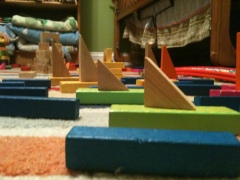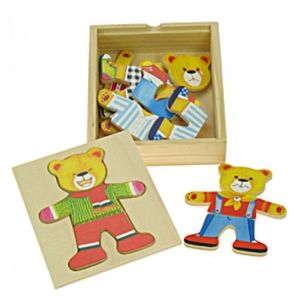Its toolbox Tuesday! Let’s see what’s in the bag today.

The Fuzzy Puzzle by Ceaco KIDS! I came across this 24 piece farmyard puzzle at my local Target. I was intrigued at the “fuzzy”. Lucky for me there was a sample piece attached to the outside of the box! WELL PLAYED Ceaco, well played.
It’s fuzzy, but not overwhelming fuzzy. The backside of the puzzle pieces are soft diamond pattered squish. I don’t know how else to describe it. Squish. Again, not overwhelmingly squishy so it was PERFECT for my kiddos. It offered a subtle tactile experience. But that’s more OT, and I’m here to talk about speech, language, and feeding. Right? Right.
This little puzzle is only four weeks old. So far, I have been able to work in a number of receptive and expressive language concepts (understanding and producing) at a variety of skill levels. So I will do my best to organize and present what I do with this little tool.
Let’s start with RECEPTIVE language, or understanding language. The following are language targets that you can focus on using the fuzzy puzzle.
- Vocabulary (cow, pig, sheep, chicken, rooster, dog, cat, bunny, birds, chicks, ducklings, butterfly, dragonfly)
- Animal sounds
- Basic concepts (together/apart)
- Counting
- identification
For example, at the most basic level, begin with one section of the puzzle, placing the pieces together . Bombardment is the first step in teaching a skill, so the phrase “Let’s put the (pig, cow, horse) together!” should come out of your mouth no less than twenty times as you construct your fuzzy farm.
After each animal is made, model the name and sound it makes. You could even drag out the Old MacDonald Had a Farm song through the entire fuzzy activity (approx. 10 mins). Sing a round of “moo moo here, and a moo moo there” each time you’ve made a new farm animal. Be sure to really ham up the animal sounds. Kids love it when you make a silly fool of yourself. If you’re working on sign language, note: make sure you have reviewed your farm animals and are ready to sign them!
Have the child find an animal that you name (identification). Have a race- see who can find it first. Of course, you can win once or twice, but praise him/her for how quick he/she found it. “You’re the fastest finder!!”
Model counting the animals. Again, bombardment is the key here. By the time you’ve completed the activity, you’ve had an opportunity to count to 5 (blackbirds/crows) and at least ten opportunities to count different animals. “How many cows do we have? One, two… TWO!”
For advanced concepts, target on top/under, next to. “the bunny is next to the birdhouse. Can you find the bunny next to the birdhouse?” There’s lots going on in the puzzle.
Now for EXPRESSIVE or producing language (speech). The skills you can target are infinite if you think about it. From one word to a thesis paper, depending on who you’re working with.
- Animal sounds
- One word animal names (labeling)
- Two words- “see ___”
- Three word sentences “I see ___.”
- 2 types of sentences, expository and interrogative
- Initiating the next piece to put together, or a turn
- Requesting using words (help, puzzle piece)
So, beginning at the basic level assemble the puzzle (with or without help from your friend)and name the first animal that is made. “Look! We made the horse! What does the horsey say?” HERE YOU MODEL WHAT YOU WANT THE CHILD TO ANSWER. It’s the perfect starting point. It gives support, lets them know what the right answer is (errorless learning), and is easily faded as you proceed. Woo-hoo the child when he/she tries to imitate what you’ve modeled. Any attempt to speak is worth gold at this level because the goal is to get them vocalizing with intention. It may not resemble the target modeled sound that you made, but hey- how good did you look the first time you tried to roller blade, ice skate, or surf???
To work on 1 to 3-word sentences, the foundation looks the same. PROMPT, MODEL, PRAISE, MODEL, PRAISE repeat. This might look like the following exchange. The child’s utterances are in parenthesis.
“Look at this one. What’s he called? (sheep) That’s right!! A sheep. Tell me “I see sheep.” (sheep) Good try. Let’s try “see sheep” (see sheep) YES!! See sheep (see sheep). Awesome, you’re a rockstar!”
The types of sentences you can target are expository (It’s a sheep) or interrogative. I like working interrogatives into my receptive task of finding the animal in the constructed puzzle. It looks like this:
“Can you find the dragonfly? Let’s call him. Dragonfly, where are you?” Depending on the child and his/her skills, answers may range from (are you?) to (fly, are you?) or (Dragonfly, where are you?). I’ll incorporate this as many times as I can for speech practice. I like to teach functional phrases from the get go. For some reason I have the vision of a small child misplacing his mommy or daddy in a store, unable to find them because he can’t say “where are you?”
Finally, requesting can be targeted with many activities. The fuzzy puzzle pieces could stay in your box, close to you, or somehow in your control. Note that in order to request, MOTIVATION MUST BE HIGH. So if your friend is “meh” interested in the puzzle it might be better to save the requesting for another activity. Focus instead on hamming up the other targets.














You must be logged in to post a comment.